

WHOEVER has followed with attention the technical treatises on flying will have become convinced that human flight cannot be brought about by one single invention, but is proceeding towards its perfection by a gradual development; for only those trials have met with success which correspond with such a development.
Formerly men sought to construct flying machines in a complete form, at once capable of solving the problem, but gradually the conviction came that our physical and technical knowledge and our practical experiences were by far insufficient to overcome a mechanical task of such magnitude without more preliminaries.
Those proceeding on this basis therefore applied themselves, not to the problem of flying as a whole, but rather divided it into its elements, and sought first to bring a clear understanding into said elements which should form the basis of final success. For example, take the laws of atmospheric resistance, upon which all flying depends, and regarding which, until very recent years, the greatest uncertainty has existed; these have now been defined to such an extent that the different phases of flight can be treated mathematically. Besides which, the physical processes of the natural flight of the creatures have become the subject of minute investigation, and have in most cases been satisfactorily explained. The nature of the wind also, and its influence on flying bodies, have been carefully studied, thus enabling us to understand several peculiarities of the birds' flight hitherto unexplainable, so that one can apply the results thus obtained in perfecting human flight.The theoretical apparatus needed for the technics of flying has been enriched so much by all these studies within the last few years that the elements of flying apparatus can now be calculated and constructed with sufficient accuracy. By means of this theoretical knowledge one is enabled to form and construct wing- and sailing-surfaces according as the intended effect renders it desirable.
But with all this, we are not yet capable of constructing and using complete flying machines which answer all requirements. Being desirous of furthering with all speed the solution of the problem of flight, men have repeatedly formed projects in these last few years which represent complete air ships moved by dynamos; but the constructors are not aware of the difficulties which await us as soon as we approach the realizing of any ideas in flying.
All those, who have occupied themselves to any extent with actual flying experiments, have found that, even if they mastered theoretically the problem of flying, the practical solving of the same can only be brought about by a gradual and wearisome series of experiments based one upon the other.
Also the practical tasks of the technics of flying should be simplified and divided as much as possible instead of steering straight to the final goal.
As these principles have been seldom carried out, the practical results in human flight have remained very scanty up to the present day.
One can get a proper insight into the practice of flying only by actual flying experiments. The journey in the air without the use of the balloon is absolutely necessary in order to gain a judgment as to the actual requirements for an independent flight. It is in the air itself that we have to develop our knowledge of the stability of flight so that a safe and sure passage through the air may be obtained, and that one can finally land without destroying the apparatus. One must gain the knowledge and the capacity needed for these things before he can occupy himself successfully with practical flying experiments.
As a rule the projectors and constructors of flying machines have not gathered this absolutely necessary practical experience, and have therefore wasted their efforts upon complicated and costly projects.
In free flight through the air a great many peculiar phenomena take place which the constructor never meets with elsewhere; in particular, those of the wind must be taken into consideration in the construction and in the employment of flying apparatus. The manner in which we have to meet the irregularities of the wind when soaring in the air can only be learnt by being in the air itself. At the same time it must be considered that one single blast of wind can destroy the apparatus and even the life of the person flying. This danger can only be avoided by becoming acquainted with the wind by constant and regular practice and by perfecting the apparatus so that we may achieve safe flight.
The only way which leads us to a quick development in human flight is a systematic and energetic practice in actual flying experiments. These experiments and exercises in flying must not only be carried out by scientists, but should also be practised by those wishing for an exciting amusement in the open air, so that the apparatus and the way of using it may by means of common use be quickly brought to the highest possible degree of perfection.
The question is therefore to find a method by which experiments in flying may be made without danger, and may at the same time be indulged in as an interesting amusement by sport-loving men.
Another condition is, that simple, easily constructed, and cheap apparatus should be used for such flying exercises, in order to conduce to a still more general participation in this sport.
All these conditions are easily fulfilled. One can fly long distances with quite simple apparatus without taxing one's strength at all, and this kind of free and safe motion through the air affords greater pleasure than any other kind of sport.
From a raised starting point, particularly from the top of a flat hill, one can, after some practice, soar through the air, reaching the earth only after having gone a great distance.
For this purpose I have hitherto employed a sailing apparatus very like the outspread pinions of a soaring bird. The drawings opposite page 22 represent such apparatus. It consists of a wooden frame covered with shirting (cotton-twill). The frame is taken hold of by the hands, the arms resting between cushions, thus supporting the body. The legs remain free for running and jumping. The steering in the air is brought about by changing the centre of gravity. This apparatus I had constructed with supporting surfaces of ten to twenty square metres. The larger sailing surfaces move in an incline of one to eight, so that one is enabled to fly eight times as far as the starting hill is high. The steering is facilitated by the rudder, which is firmly fastened behind in a horizontal and vertical position.
The machines weigh, according to their size, from 15 to 25 kilograms (33 to 55 lbs.).
In order to practise flying with these sailing surfaces one first takes short jumps on a somewhat inclined surface till he has accustomed himself to be borne by the air. Finally, he is able to sail over inclined surfaces as far as he wishes.
The supporting capacity of the air is felt, particularly if there is a breeze. A sudden increase in the wind causes a longer, stoppage in the air, or one is raised to a still higher point.
The charm of such flight is indescribable, and there could not be a healthier motion or more exciting sport in the open air.
The rivalry in these exercises cannot but lead to a constant perfecting of the apparatus, the same as, for instance, is the case with bicycles. I speak from experience, for, although the system of my sailing apparatus remains the same, it has gone through numberless changes from year to year.l
The apparatus which I now employ for my flying exercises contains a great many improvements as compared with the first sailing surfaces with which I commenced this kind of experiment five years ago. The first attempts in windy weather taught me that suitable steering surfaces would be needed to enable me to keep my course better against the wind. Repeated changes in the construction led to a kind of apparatus with which one can throw himself without danger from any height, reaching the earth safely after a long distance. The construction of the machine is such that it resembles in all its parts a strut frame, the joints of which are calculated to stand pull and pressure, in order to combine the greatest strength with the least weight.
An important improvement was to arrange the apparatus for folding which can be seen the most clearly in the figure opposite page 22. All of my recent machines are so arranged that they can be taken through a door 2 metres high. The unfolding and putting together of the flying implements takes about two minutes.
A single grip of the hands is sufficient to attach the apparatus safely to the body, and one gets out of the apparatus just as quickly on landing. In case of a storm the flying sail is folded up in half a minute and can be laid by anywhere. If one should not care to fold the apparatus, he may await the end of the storm under cover of the wings, which are capable of protecting twenty persons. Even the heaviest rain will not damage the apparatus. The flying apparatus, even if completely drenched, is soon dried by a few sailing flights after the rain stops, as the air passes through the same with great speed.
The latest improvements of the flying apparatus which I use for practical experiments refer to gaining of greater stability in windy weather.
My experiments tend particularly in two directions. On the one side I endeavor to carry my experiments in sailing through the air with immovable wings to this extent; I practise the overcoming of the wind in order to penetrate, if possible, into the secret of continued soaring flight. On the other hand I try to attain the dynamic flight by means of flapping the wings, which are introduced as a simple addition to my sailing flights. The mechanical contrivances necessary for the latter, which can reach a certain perfection only by gradual development, do not allow yet of my making known any definite results. But I may state that since my sailing flights of last summer, I am on much more intimate terms with the wind.
What has prevented me till now from using winds of any strength for my sailing experiments, has been the danger of a violent fall through the air, if I should not succeed in retaining the apparatus in those positions by which one insures a gentle landing. The wildly rushing wind tries to dash about the free floating body, and if the apparatus take up a position, if only for a short time, in which the wind strikes the flying surfaces from above, the flying body shoots downward like an arrow, and can be smashed to pieces before one succeeds in attaining a more favorable position in which the wind exercises a supporting effect. The stronger the wind blows, the easier this danger occurs, as the gusts of wind are so much the more irregular and violent.
As long as the commotion of the air is but slight, one does not require much practice to go quite long distances without danger. But the practice with strong winds is interesting and instructive, because one is at times supported quite by the wind alone. The size of the apparatus, however, unhappily limits us. We may not span the sailing-surfaces beyond a certain measure, if we do not wish to make it impossible to manage them in gusty weather. If the surfaces of 14 square metres do not measure more than 7 metres2 from point to point, we can eventually overcome moderate winds of about 7 metres3 velocity, provided one is well practised. With an apparatus of this size it has happened to me that a sudden increase in the wind has taken me way up out of the usual course of flying, and has sometimes kept me for several seconds at one point of the air. It has happened in such a case, that I have been lifted vertically by a gust of wind from the top of the hill (shown in Fig. 3), floating for a time above the same at a height of about 5 metres whence I then continued my flight, against the wind.
Although, while making these experiments I was thrown about by the wind quite violently and was made to execute quite a dance in the air in order to keep my balance, I yet was always,, enabled to effect a safe landing, but still I came to the conviction, that an increase in the size of the wings or the utilizing of still stronger winds which would lengthen the journey in the air, would necessitate something being done, to perfect the steering and to facilitate the management of the apparatus. This appeared to me to be all the more important as it is very necessary for the development of human flight that all, who take up such experiments, should quickly learn how to use the apparatus safely and understand how to use the same even if the air is disturbed. It is in the wind that this practice becomes so exciting and bears the character of a sport, for all the flights differ from each other and the adroitness of the sailing-man has the largest field for showing itself. Courage also and decision can be here shown in a high degree.
If such exercises are gone through with in a regular and approved method, they are not more dangerous than if one engages in riding, or sailing on the water.
Just as it is in sports on the water, so it is in sports in the air, that the greatest aim will be to reach the most startling results. The machines themselves, as well as the adroitness of their operators, will vie with each other.
He who succeeds in flying the farthest from a certain starting-point, will come forth from the contest as conqueror. This fact will necessarily lead to the production of more and more improved flying apparatus. In a short time we shall have improvements of which to-day we have not the faintest idea.
The foundation for such a development exists already; it only needs a more thorough carrying out to gain perfection. The greater the number is of such persons who have the furthering of flying and the perfecting of the flying apparatus at heart the quicker we shall succeed in reaching a perfect flight. It is therefore of paramount importance that as many physically and technically well trained men as possible take interest in these affairs, and that an apparatus be constructed which is as convenient and as cheap as possible.
The means by which I sought to facilitate the management of the machines and to increase their use in wind, consisted in the first place in different arrangements for changing the shape of the wings at will. I will, however, pass over the results here obtained as another principle gave surprisingly favorable results.
My experiments in sailing flight have accustomed me to bring about the steering by simply changing the centre of gravity.
The smaller the surface extension of the apparatus is, the better control I have over it, and yet if I employ smaller bearing surfaces in stronger winds, the results are not more favorable. The idea therefore occurred to me to apply two smaller surfaces, one above the other, which both have a lifting effect when sailing through the air. Thus the same result must follow which would be gained by a single surface of twice the bearing capacity, but on account of its small dimensions this apparatus obeys much better the changes of the centre of gravity.

Fig. 1.
Before I proceeded to construct these double-sailing machines, I made small models in paper after that system, in order to study the free movements in the air of such flying bodies and then to construct my apparatus on a large scale, depending on the results thus obtained. The very first experiments with these small models, the form of which may be seen in Figs. 1 and 2, surprised me greatly on account of the stability of their flight. It appears as if the arrangement of having one surface over the other had materially increased the safety and uniformity of the flight. As a rule it is rather difficult to produce models resembling birds, which, left to themselves, glide through the air from a higher point in uniformly inclined lines. I need only recall the extensive and expensive experiments made by Messrs. Riedinger, von Sigsfeld, and von Parsefal, of Augsburg, which showed the difficulty of constructing models that would automatically take up a course of stable flight. I myself doubted formerly very much that an inanimate body sailing quickly forward, could be well balanced in the air, and was all the better pleased in succeeding in this with my little double surfaces.

Fig. 2.
Relying on this experience I constructed first a double apparatus (Fig. 3), in which each surface contains 9 square metres4. I thus produced a comparatively large bearing surface of 18 square metres with but 5 1/2 metres5 span.
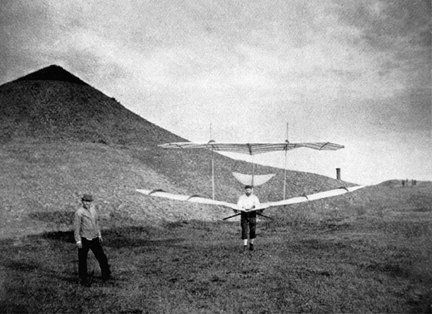
Fig. 3.
The upper surface is separated from the lower by a distance equal to three quarters of the breadth of the lower surface, and it has no disturbing influence whatever, but creates only a vertically acting lifting force. One must consider that with such an apparatus one always cuts the air quickly, so that both surfaces are met by the air-current, and therefore both act as lifters.
The whole management of such an apparatus is just the same as that of a single sailing surface. I could, therefore, use at once the skill I had already obtained.
Fig. 4 shows how I have to change the centre of gravity, and particularly the position of the legs, to the left, in order to press down the left wing, which is a little raised. In Fig. 5 the opposite movement to the right is shown. I retain the middle position, as shown in the frontispiece, whenever the apparatus floats horizontally.
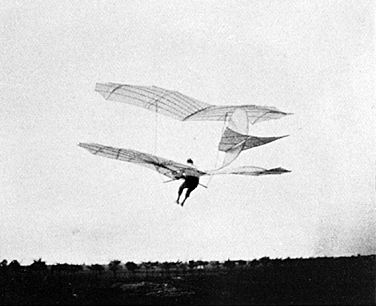
Fig. 4.
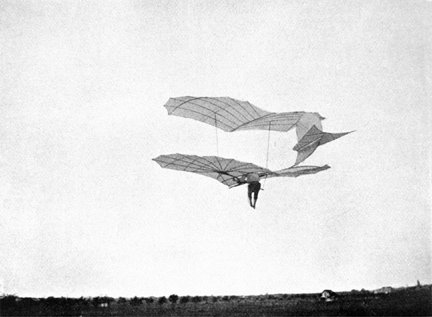
Fig. 5.
The flights undertaken with such double sailing surfaces are distinguished by their great height, as is shown in Fig. 6, which gives a side-view of the apparatus.
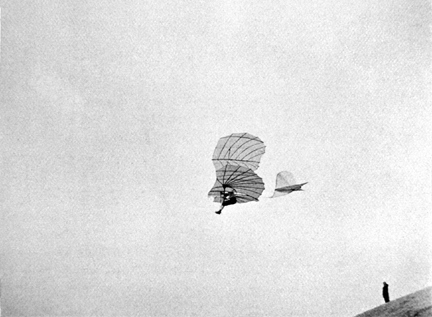
Fig. 6.
The landing with this apparatus is brought about in the same way as with the single sailing surfaces by raising the apparatus in front somewhat and by lessening the speed, as shown in Fig. 7.
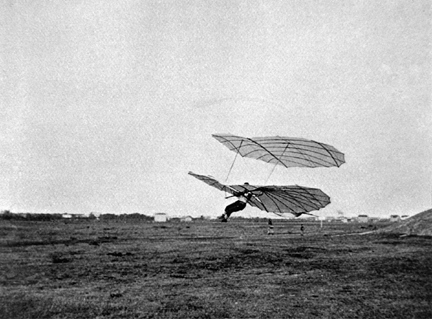
Fig. 7.
Fig. 8 shows an exact picture of the construction of the, apparatus, as well as of the management of the same.
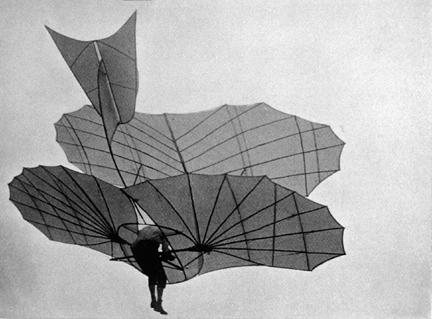
Fig. 8.
The energetic effect of the change of the centre of gravity and the safe starting of the apparatus obtained by it gave me courage to trust myself to a wind which at times exceeded a velocity of 10 metres (about 24 miles per hour).
This gave the most interesting results of all my practical flying experiments hitherto. Six or seven metres velocity of wind sufficed to enable the sailing surface of 18 square metres to carry me almost horizontally against the wind from the top of my hill without any starting jump. If the wind is stronger, I allow myself to be simply lifted from the point of the hill and to sail slowly towards the wind. The direction of the flight has, with strong wind, a strong upward tendency. I often reach positions in the air which are much higher than my starting-point. At the climax of such a line of flight I sometimes come to a standstill for some time, so that I am enabled while floating to speak with the gentlemen who wish to photograph me, regarding the best position for the photographing.6
At such times I feel plainly that I would remain floating if I leaned a little towards one side, described a circle and proceeded with the wind. The wind itself tends to bring this motion about, for my chief occupation in the air consists in preventing a turn either to right or the left, and I know that the hill from which I started lies behind and underneath me, and that I might come into rough contact with it if I attempted circling. My endeavors tend therefore to remove myself farther from the hill either by increased wind or by flapping with the wings, so that I can follow the strongly lifting air-current in a circle, and so that I can have a sufficient space of air under and beside me to succeed in describing with safety a circling flight and to land finally steering against the wind.
As soon as I or any other experimenter succeeds in describing the first circling flight, one may regard this event as one of the most important conquests on the road to perfect flight. From this moment only, one is enabled to make a thorough use of the vis viva of the wind, so that when the wind increases one is able to steer against it, and when it decreases one can fly with it, getting beyond the same. One will feel here a similar effect, as already described by Professor Langley in his celebrated treatise entitled "The Internal Work of the Wind." It is no easy step from the theoretical conviction to the practical execution. The dexterity required to allow one's self to be borne by the wind alone, by describing well directed circles, is only understood by those who are well acquainted with the difficulties one encounters with the wind. And yet all that may be acquired by practice. When the time comes that athletic associations emulate each other, such results will not be long in following.
Moreover, experimenters will proceed from simple floating and sailing, which in any case form the foundation for practical flight, by degrees to flying with movable implements. As one is enabled to balance himself for some time in the air, the foundations for more extended dynamic effects are easily and safely attained. The different projects may be easily tried by adding the motor work to the simple sailing flight taken as a basis. In this manner one will soon find out the best methods; for practical experience in the air is far better than figuring on paper.
The only thing which may cause difficulties is the procuring of a suitable place for practising.
Just as the starting from the earth is rather difficult for larger birds, the human body, being still heavier, meets with peculiar difficulties at the first flight upward. The larger birds take a running start against the wind or throw themselves into the air from elevated points, in order to obtain free use of their pinions. As soon, however, as they float in the air, their flight, which was begun under special difficulties, is easily continued. The case is similar in human flight. The principal difficulty is the launching into the air, and that will always necessitate special preparations. A man will also have to take a running start against the wind with his flying apparatus, but on a horizontal surface even that will not be sufficient to free himself from the earth. But, on taking a running start from a correspondingly inclined surface, it is easy to begin one's flight even if there is no wind.
According to the example of birds, man will have to start against the wind; but as an inclined surface is necessary for this he needs a hill having the shape of a flat cone, from the top of which he may take starts against the wind in any direction .
Such a place is absolutely necessary, if one wishes to make flying experiments in a convenient way without being dependent on the direction of the wind.
For this purpose I have had an artificial hill, 15 metres high, erected near my house in Gross Lichterfelde, near Berlin, and so have been enabled to make numerous experiments. The drawings show this hill, or part of the same, from the outside. Fig. 9 represents a section of it, showing the cavity in the top intended for keeping the apparatus. At the same time the line of flight taken in calm weather is shown by dotted lines.

Fig. 9.
If a place for this sport is procured where young persons wishing to indulge in flight can disport themselves in the air, they will then have a chance to make instructive and interesting sailing flights, and I should advise having the hill twice as high, and to form it according to Fig. 10, so that one can commence the flights from a height of 30 metres. The cavity inside should be large enough to hold several complete machines.
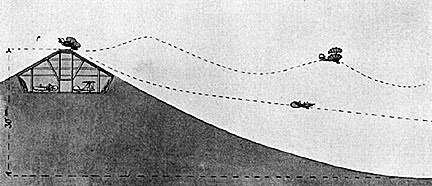
Fig. 10.
From such a hill one can take flight of 200 metres distance, and the floating through the air on such long distances affords indescribable pleasure. Added to which this highly exciting exercise is not dangerous, as one can effect a safe landing at any time.
Such a place in which young men can practise sailing flights and can at times make motor experiments with the wings would prove to be of great interest, both to those participating and to the public in general.
And when, from time to time, competitive flights were arranged, we should soon have a national amusement in this as in other sports which we have already. One can see even now that the pleasure and interest of the public in such races, when the gymnasts skilled in flights, shoot through the air, would be greater and more intense than, for instance, in horse or boat racing. The air is the freest element; it admits of the most unfettered movement, and the motion through it affords the greatest delight not only to the person flying, but also to those looking on. It is with astonishment and admiration that we follow the air gymnast swinging himself from trapeze to trapeze; but what are these tiny springs as compared to the powerful bound which the sailer in the air is able to take from the top of the hill, and which carries him over the ground for hundreds of yards ?
If the atmosphere is undisturbed, the experimenter sails with uniform speed; as soon, however, as even a slight breeze springs up, the course of the flight becomes irregular, as indicated in Fig. 10. The apparatus inclines now to the right, now to the left.
The person flying ascends from the usual line of flight, and, borne by the wind, suddenly remains floating at a point high up in the air; the on lookers hold their breath; all at once cheers are heard, the sailer proceeds and glides amid the joyful exclamations of the multitude in a graceful curve back again to the earth.
Can any sport be more exciting than flying? Strength and adroitness, courage and decision, can nowhere gain such triumphs as in these gigantic bounds into the air, when the gymnast safely steers his soaring machine house-high over the heads of the spectators.
That the danger here is easily avoided when one practises in a reasonable way, I have sufficiently proved, as I myself have made thousands of experiments within the last five years, and have had no accidents whatever, a few scratches excepted.
But all this is only a means to the end; our aim remains--the developing of human flight to as high a standard as possible. If we can succeed in enticing to the hill the young men who to day make use of the bicycle and the boat to strengthen their nerves and muscle, so that, borne by their wings, they may glide through the air, we shall then have directed the development of human flight into a course which leads towards perfection.
Footnotes
1 See article entitled "Wheeling and
Flying."
2 About 23 feet.
3 About 22 miles
4 About 97 sq. feet.
5 About 18 feet.
6 The photographs were made by Drs. Neuhaus
and Fullerborn, who used a camera constructed by Dr. Neuhaus on the
Stegemann principle.
Webmaster's note: This article appeared in the 1896 edition of James Means' The Aeronautical Annual, pp. 7-20. Scan by Cory Kotowsky; HTML and photos by Gary Bradshaw.